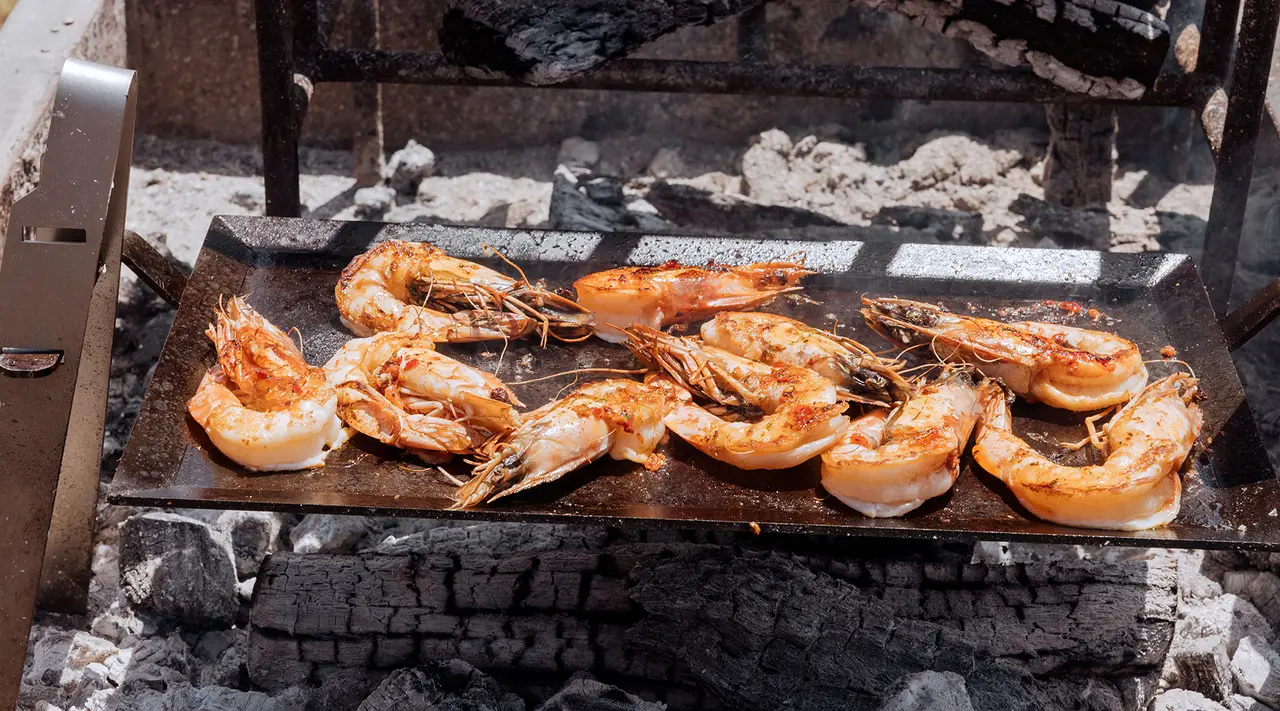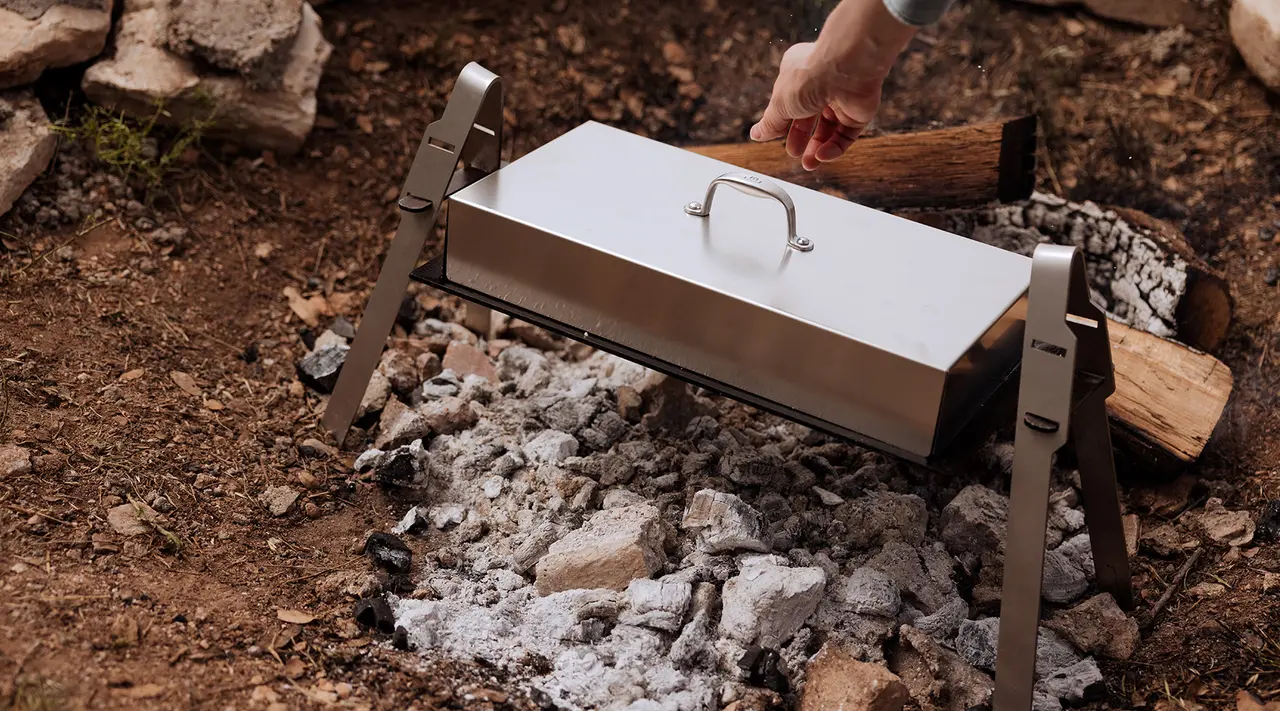The minute we set our clocks forward in March, we start craving all things cooked al fresco. But before you pull the tarp off your trusty grill, you might want to give yourself a quick refresh on outdoor cooking—especially if you haven't touched an outdoor burner since Labor Day.
From how to prep in advance to which tools to have on hand, here’s how to safely and easily cook food outside.
Tip #1: Select Your Outdoor Cooking Method
There are numerous methods for outdoor cooking, but these are the three most common.
On the Grill
Next to using a portable stove, grilling is probably the most common—and beginner-friendly—way of cooking outdoors. A typical outdoor grill, like the Made In Grill, combines a heating element, fuel, and a cooking surface all in one. Once you’ve filled the propane tank or added charcoal to the base of the grill (depending on whether you’re using gas or charcoal), all that’s left is to apply heat, add your food to the grates, and then cut the gas or close the air dampers on your charcoal grill when you’re done.
Campfire or Live Fire
Live-fire cooking is perfect for when you want to go completely off the grid: this method of cooking requires time, patience, and a beginner’s knowledge of how to build a fire (plus a decent grill pan, griddle, or cast iron skillet).
You can cook pretty much anything over a fire that you would on a grill, though keep in mind that it’s harder to adjust the temperature than with a gas grill (a removable lid helps modulate temperature and intensity, though).
Portable Camping Stoves
Portable stoves can be a great compromise for those who want to cook while camping, but don’t feel comfortable or have the ability to cook over a campfire. The simplest versions of these stoves sport a single, butane- or propane-powered burner, while more elaborate ones—i.e. “camp stoves” — might offer multiple burners and better temperature control.
Tip #2: Pack the Right Tools

Outdoor cooking doesn’t have to be difficult, but it does require a slightly different setup than cooking in your home kitchen. From a good pair of grill tongs to the right kind of fuel for your gas or charcoal grill, here’s how to set yourself up for outdoor cooking success.
Cookware
If you’re already cooking on a grill, you don’t necessarily need any additional cookware. But for easier cleanup, and for getting an evenly browned crust on foods like steaks, we like to reach for a grill frying pan or griddle. Using a grill pan or griddle makes it easier to cook smaller items, like shrimp or cut-up vegetables, without losing them through the grill grate or having to thread them onto skewers. This also enables you to quickly move your food from one heat zone to another, which reduces the risk of overcooking.
Regardless of the cookware you opt for, we recommend sticking to carbon steel. Since it can withstand incredibly high temperatures—up to 1200F—you can hold a carbon steel pan directly over a campfire or place it on top of burning embers without it warping. It’s also naturally non stick and is much lighter weight than cast iron, the other, heavier cookware material for live-fire cooking.
Accessories
While grilling enthusiasts have an endless variety of specialized tools to pick from, the basics include an extra-long set of tongs with a wood or silicone handle; a long-handled spatula; and a barbecue fork for spearing food. We also like to have a set of oven mitts or kitchen towels on hand for pulling hot pans off the fire.
Larger cooking surfaces like griddles may also come with a stand that elevates your cooking surface above coal or flames. You’ll also want to have a set of outdoor-friendly plateware—especially if you’re cooking somewhere that’s not your own terrace or backyard. Otherwise, a stack of compostable plates can come in handy for serving and holding ingredients.
Fire-Starting Essentials
Before defrosting your steaks, you’ll want to make sure you’ve got the right fuel for your outdoor cooking setup. For charcoal grilling, you can buy bags of charcoal in either briquette (the most common) or lump form, which gets dumped directly into the base of the grill or into a hollow steel cylinder called a chimney starter. If you’re cooking with a gas grill, you’ll need to buy a tank of propane, which hooks up directly to your grill.
Finally, for campfire and other open fire cooking, you’ll want to gather a combination of firewood and kindling—i.e. large pieces of wood and smaller sticks—along with tinder, which consists of small, flammable materials like twigs, moss, and dry leaves.
Tip #3: Prep Recipes in Advance
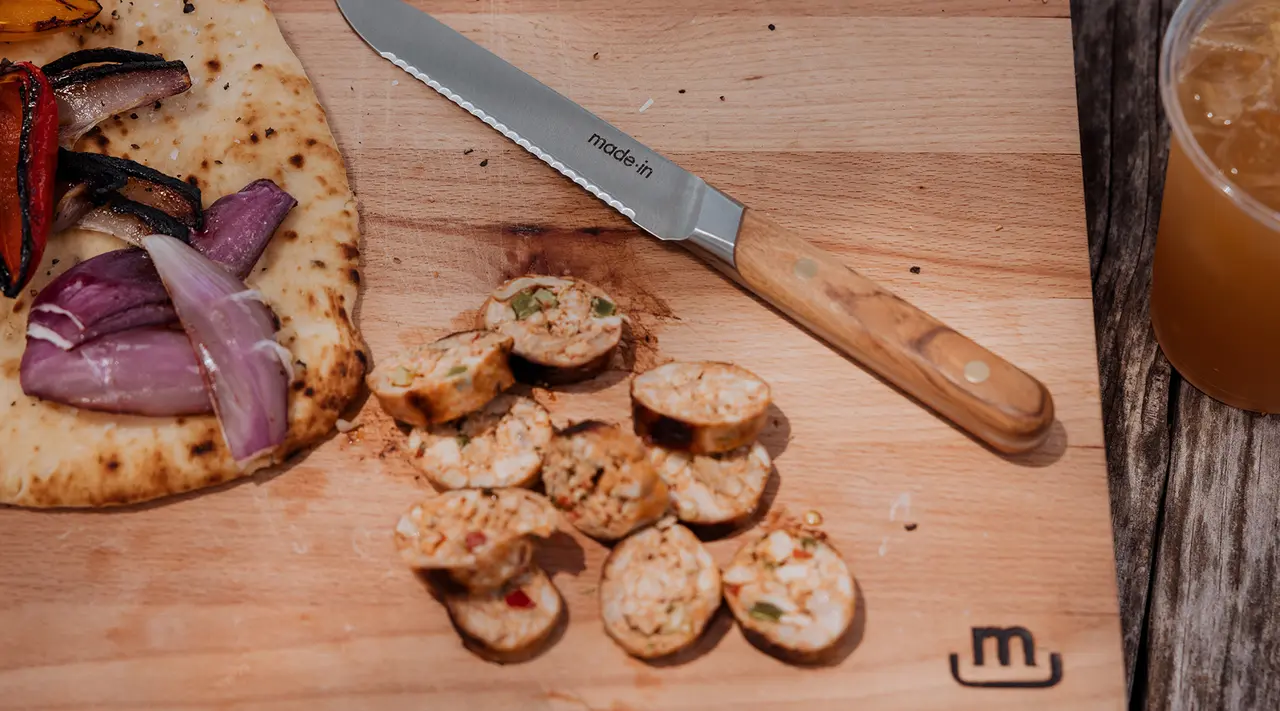
Unless you’re cooking in your backyard, it’s safe to assume you won’t have access to a functioning kitchen when cooking outside. Since it’s often trickier to wash and chop vegetables and meat when you’re outdoors, you’ll want to get all or most of the prep done before you head out. This is for convenience as well as safety: It’s cumbersome, and potentially risky, to pack a sharp knife with you.
Doing advance prep also makes it much easier to cook more involved recipes like seafood paella, juicy steak sandwiches, and whole grilled fish outside. While we love a great hamburger or hot dog, there’s something almost life-affirming about getting to cook—and eat—an elegant meal completely al fresco.
Tip #4: Fire Safety First
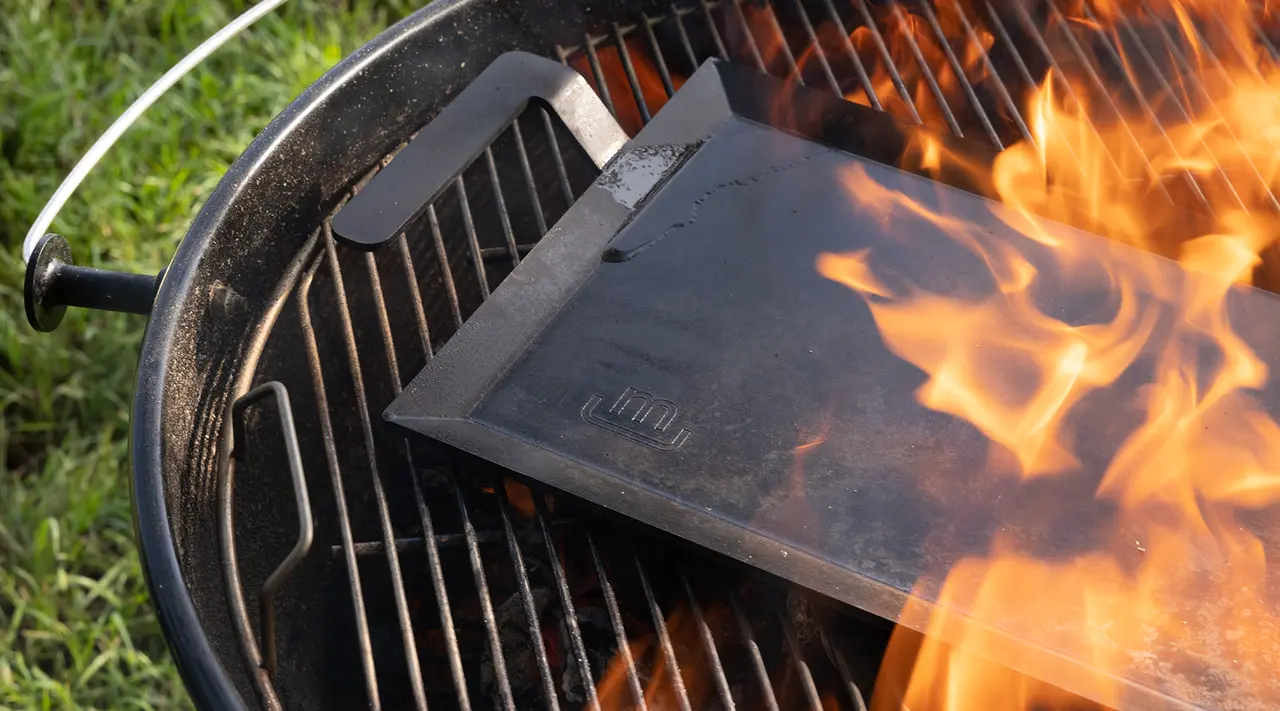
Cooking with fire can be totally safe—if you practice caution. Never leave a grill or campfire unattended. This will not only save your food from being burnt to a crisp, but will also give you time to react if the fire starts to spread or the gas tank springs a leak.
Open Fire Safety
This is especially crucial when cooking in the woods or surrounded by dry brush or grass, as a small flame can quickly grow into a wildfire—always clear an area and note your surroundings before lighting any matches. Prior to cooking outdoors, make sure to read up on grill safety, as well as how to safely build and extinguish a campfire.
With campfires or fire pits, changing the temperature involves adjusting the amount and positioning of kindling or fanning the flames. You can also prevent your food from overcooking by setting up different heat zones—having an “indirect heat zone,” i.e. an area away from the flames, allows you to cook more delicate foods or finish cooking a piece of meat that’s already sufficiently seared.
Grill Safety
For grilling, make sure the hood of your gas grill is open before turning it on, as a closed hood can cause heat to build up, creating a large fire or even an explosion. While cooking, make sure to watch out for flare-ups, which are typically caused by grease dripping through the grates. You can prevent this by using a carbon steel frying pan or griddle on top of the grates when cooking fatty proteins like steaks or pork chops, as well as by cleaning your grill thoroughly after using (once it’s cooled, of course).
Tip #5: Pack it in, Pack it Out
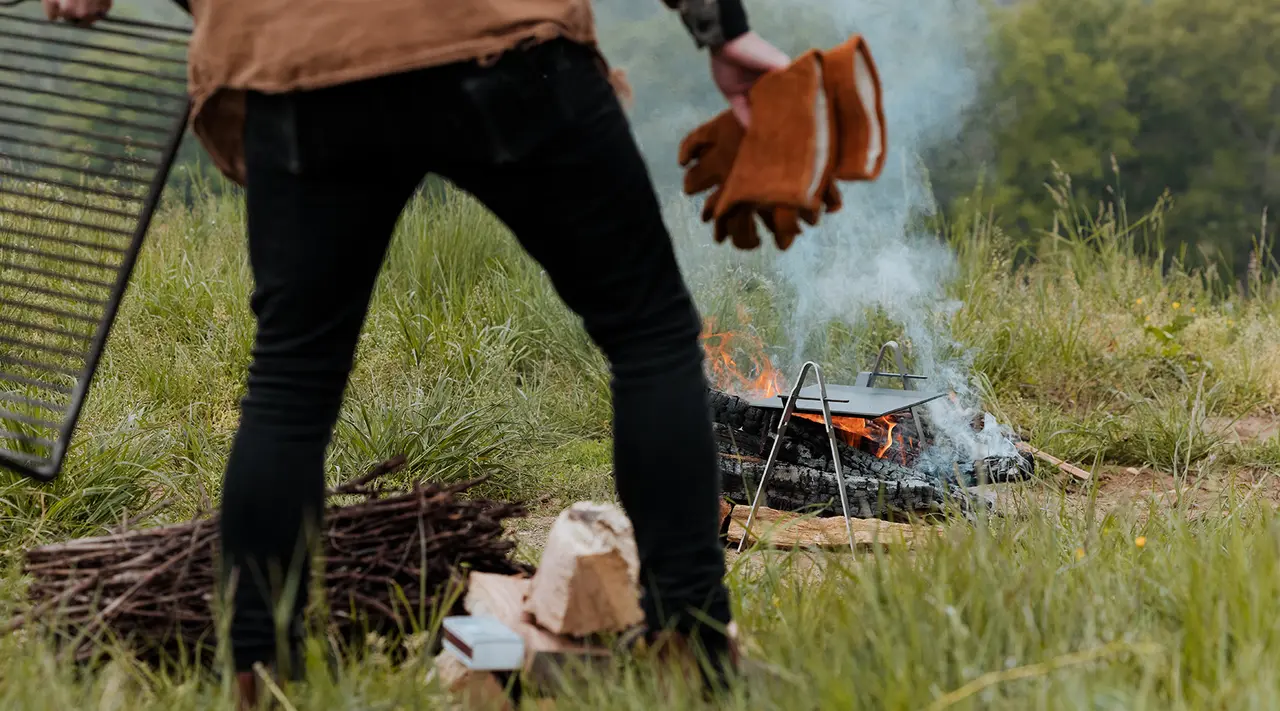
Along with practicing safety while cooking, you should always make sure to clean up soon after cooking and eating outdoors. Not only does this show respect for the environment and for anyone using the space after you, but it’ll help you avoid attracting bugs, rodents, and larger animals (like bears!) eager to feast on your scraps.
While this might all sound overly complicated, remember: this is the time to slow down and get back in touch with your senses. There’s nothing instant about cooking outdoors—and that’s kind of the whole point! So grab a cold beer and take a beat: It’s summer, after all.
Ready to Cook?
The logistics of outdoor cooking might be slightly more complicated than cooking indoors, especially if you’re on the beach or in the woods. But with a little bit of advance preparation and planning, cooking over an open flame in the great outdoors can be an incredibly rewarding—and relaxing—experience.
With carbon steel cookware, cooking great-tasting food outdoors is even easier. Whether you’re using it on the Made In Grill or directly over an open flame, our carbon steel pans are super compatible with grilling and open fire cooking, making for deeper sears, better browning, and even more of that coveted char.


